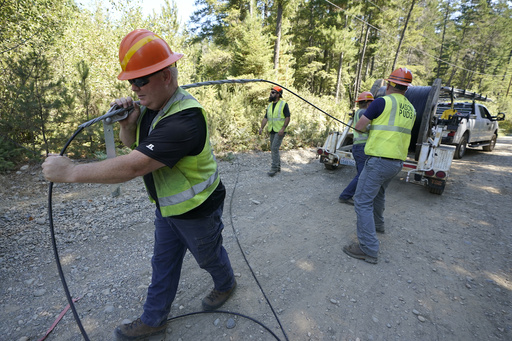
With just four days remaining before Election Day, the government is preparing to release its final report on hiring and unemployment in the United States. This comes during a presidential campaign marked by significant voter scrutiny of the economy’s performance.
However, the upcoming report, slated for release on Friday, is expected to present some of the most skewed monthly employment data in recent years. The aftermath of hurricanes and significant worker strikes has temporarily limited job growth in October. Therefore, rather than gaining a comprehensive interpretation of the economy, voters, politicians, and Federal Reserve officials will instead receive a complicated portrayal of recent employment trends. This situation is further complicated by allies of former President Donald Trump, who are attempting to challenge the public’s confidence in the economy’s health by questioning the validity of monthly jobs reports.
Trump and his supporters have consistently criticized the Biden-Harris administration for the inflation surge that reached its peak two years ago, despite a trend of cooling inflation afterward. While the job market remains strong with minimal layoffs and low unemployment figures, Trump has labeled the U.S. a “failing nation” and has proposed implementing extensive tariffs on all imported goods, claiming this would revive millions of manufacturing jobs.
Historically, monthly employment figures provide much-needed clarity regarding economic conditions. Yet experts estimate that the combined effects of Hurricanes Helene and Milton, along with the ongoing Boeing machinists’ strike, have significantly dampened hiring figures, potentially lowering job additions by 60,000 to 100,000 positions last month. Overall, analysts forecast that Friday’s report will indicate that approximately 120,000 jobs were created in October. While this number may seem decent, it pales in comparison to the unexpectedly robust addition of 254,000 positions recorded in September. The unemployment rate is anticipated to stay steady at a low 4.1%.
Taking into account the influences of the hurricanes and labor strikes, even these figures should suggest a strong job market, which has demonstrated surprising resilience, fueled by robust consumer spending amid high-interest rates from the Fed. “This is a really incredibly resilient economy,” stated Jane Oates, a former Labor Department official under Obama. “People are spending. That’s what’s keeping this economy going.”
Nonetheless, certain impacts may slip under the radar for the government to accurately track. The Labor Department has acknowledged that the Boeing machinists’ strike, along with a smaller strike involving some hotel workers, cut job growth potentially by 41,000 positions in October. Additionally, jobs tied to some of Boeing’s suppliers might have been lost as their sales dipped due to the strike, but quantifying that effect on overall employment numbers remains ambiguous.
Furthermore, the extent of job losses attributed to the hurricanes might be less severe than anticipated. For a job to be classified as lost within government reports, a worker needs to miss an entire pay period—typically two weeks. Many workers in North Carolina may have been out of work for that long, but more seasoned employees in Florida might not have experienced such prolonged disruptions, as indicated by Oates.
Analysts at UBS observed that prominent amusement parks in Orlando, including Walt Disney World, Sea World, and Universal, were closed for only two days following Hurricane Milton. Moreover, recovery and rebuilding efforts in several states could lead to new job opportunities.
The Friday jobs report will serve as a key economic indicator ahead of the Fed’s upcoming meeting on November 7, which occurs just two days after the election. Many economists are anticipating that the Fed will lower its benchmark interest rate by a quarter-point, following a notable half-point cut in September.
If Friday’s employment figures reflect healthy hiring in October, excluding the effects of the hurricanes and labor strike, Republican figures may challenge the report’s reliability once again. Last month, after an unexpectedly strong hiring report for September, Florida Senator Marco Rubio claimed, without evidence, that the data was “fake.”
However, mainstream economists do not share this skepticism, as other metrics—including unemployment benefit claims—also suggest a stable job market. “I’ve been horrified by the degree to which politicians have made that argument,” remarked Julia Pollak, chief economist at ZipRecruiter. She emphasized that the Labor Department’s Bureau of Labor Statistics, responsible for the jobs report, is among the most transparent agencies in the government.
Critics like Trump have exploited the routine revisions that government’s preliminary estimates undergo to suggest manipulation of data by the Biden-Harris administration. For instance, the Bureau of Labor Statistics announced in August its plan to reduce its March job estimates by 818,000, forming the basis for Trump’s claims of “fraud” in employment statistics. However, the Bureau also downgraded job counts during Trump’s presidency, with a downward revision of 514,000 in 2019.
Erica Groshen, a senior economic advisor at Cornell University and a former BLS commissioner, clarified that these revisions are “not a bug; they are a feature” of data collection by the government. “BLS aims to share timely information while ensuring accuracy,” Groshen highlighted.
Some Republican politicians, including Trump’s running mate Sen. JD Vance, have attempted to discredit positive hiring statistics by asserting that job growth in the past year largely benefitted immigrants. This argument stems from the BLS report stating that the number of “foreign-born” workers increased by 1.2 million in September compared to the previous year, while native-born workers declined by around 800,000.
However, the “foreign-born” category can include long-term residents who are now citizens, along with more recent immigrants—both authorized and undocumented. Moreover, a significant factor in the employment landscape is the mass retirement of native-born Americans, which has contributed to widespread difficulties for employers seeking candidates. The proportion of Americans aged 65 and older surged to 17.3%, up from 13.1% in 2010, according to Census Bureau statistics. Current unemployment for native-born Americans stands at 3.8%, which is lower than the 4.2% jobless rate for foreign-born workers.
